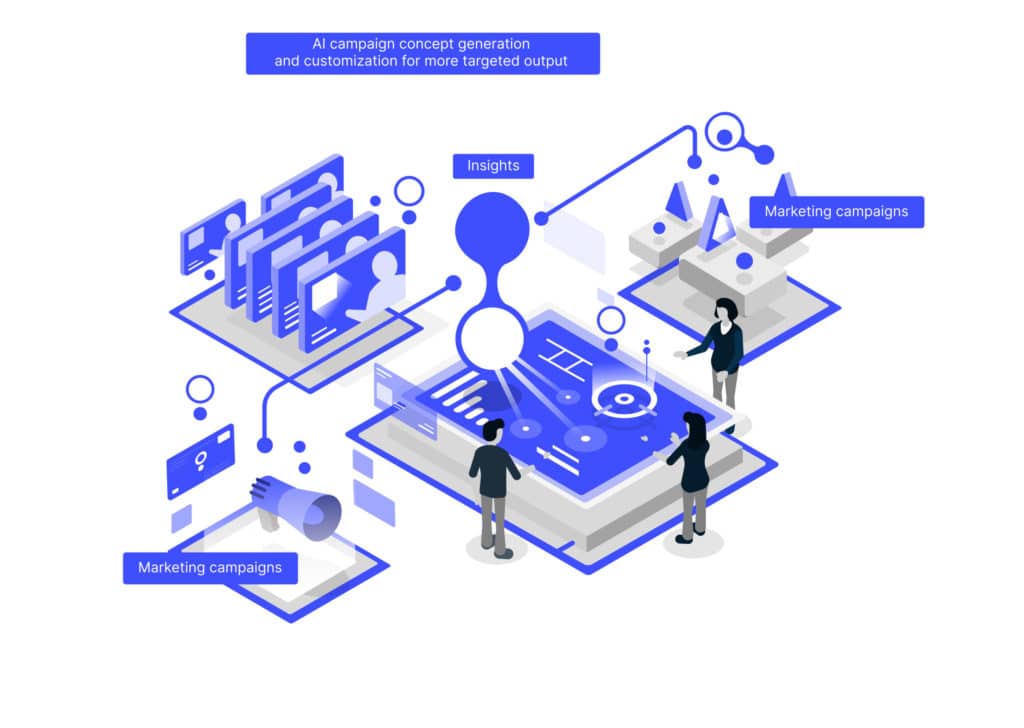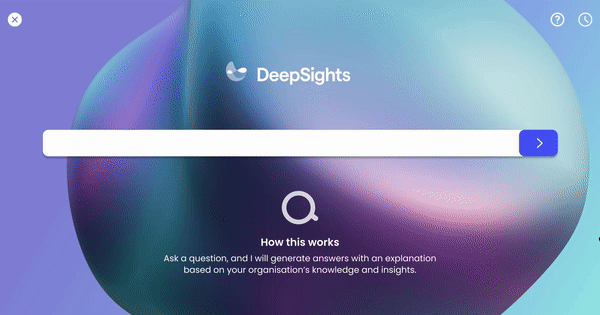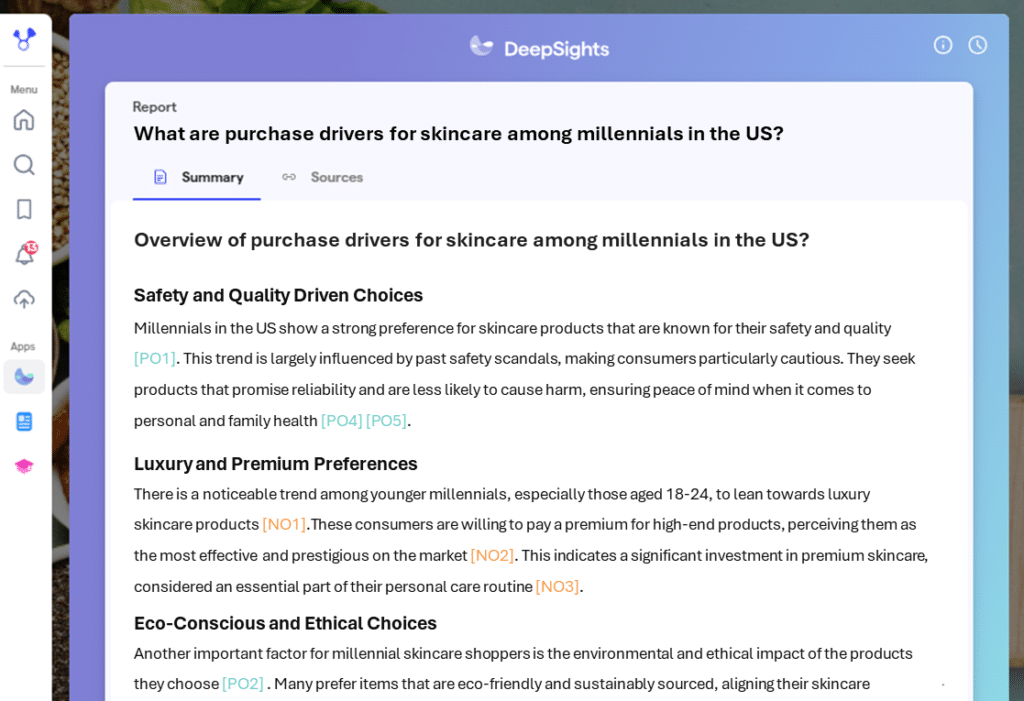Artificial intelligence (AI) tools for insights are emerging and changing at an unprecedented rate. The sheer volume of AI platforms available can be overwhelming for businesses, but one thing is becoming increasingly clear: there is no one-size-fits-all AI insights solution.
For insights and intelligence professionals, the challenge lies in selecting the right AI insights tools that not only address specific insights needs but also integrate seamlessly into your existing tech stack.
In this blog post, we introduce three categories of AI for market and consumer insights with a case study for each, then we talk about the top three things to consider when choosing the right AI solutions to run an insights-driven business.
The content is inspired by ESOMAR’s AI tools demo presentation, which focused on how generative AI can transform how research, data, and insights are acted on within your organization. Industry experts Judith Passingham, Chair of the Professional Standards Committee at ESOMAR, Ben Hsieh, Cofounder at Synapbox, Bradley Taylor, Senior Strategist at Converseon.AI, Christian Bobzin, Senior Director of Experience & Design at Market Logic, and Vedran Jelaca, CEO at Shopnosis, attended the event. You can watch the recording on-demand here.
What kinds of AI insights solutions are out there?
As an insights professional, it’s wise for you to develop a good baseline knowledge of the diverse and evolving AI landscape and the types of tools that are emerging. When you do, you’ll better understand which AI technologies fit within your organization’s strategic goals and existing systems and processes. Then, you’ll be ready to guide your organization to more informed and effective decision-making around AI.
Dive into some use cases below to uncover the potential of new AI insights technology, and how you can effectively leverage it to boost the ROI of your marketing campaigns.
AI for content testing
Use case: Get AI-powered insights for video advertising campaigns
Imagine you’re an insights professional at a marketing firm that specializes in creating and optimizing video content for advertising campaigns. Traditional methods of video content testing often rely on focus groups and simple data analysis, which can fail to capture the full spectrum of consumer responses to each visual and scene in your many video advertisements.
To tackle this, your firm adopts a generative AI system that integrates eye-tracking and emotional recognition technology via webcams. The AI tool then records detailed consumer responses as they interact with your video ads. It tracks where they look, their emotional reactions, and verbal feedback. It then creates a comprehensive dataset of engagement metrics. Additionally, each video element — like logos, visuals, key messages, and calls to action — is also indexed and analyzed for effectiveness. This is made possible by using a sophisticated algorithm that references a decade’s worth of data on creative successes.

Based on these results, you can now easily filter visuals and view graphs that help you predict which scenes will resonate most with specific demographics. These findings allow you to advise your creative team on how to tailor the campaign content, ensuring it connects deeply with its intended audience — for better results.
Given that AI can handle vast amounts of data simultaneously, you’re now able to analyze data from multiple video campaigns at once, leading to quicker iterations and optimizations based on consumer feedback and engagement metrics.
Finally, with the support of AI, you can now perform comprehensive ad evaluations at scale, mimicking the depth and precision of unlimited expert research with a level of accuracy and personalization that was not possible before.
AI for predictive analytics
Use case: Turn Voice of Customer (VoC) data into predictive brand reputation intelligence
In this scenario, you’re an insights professional at a leading retail company and you want to understand how increasing your commitment to certain initiatives will impact your brand reputation and, consequently, your financial performance.
You enlist an AI-powered predictive reputation intelligence system to help you understand where your company stands with customers. Because the system leverages new AI technology to conduct sentiment analysis, it can analyze high volumes of VoC data and better understand context and nuance in customer feedback. For instance, it can grasp irony, sarcasm, and ambiguity, and it can determine sentiments that depend heavily on cultural or situational contexts.
After the analysis of customer data, your AI dashboard shows you that your company scores low on LGBTQ+ inclusion and support. You navigate to the predictive dashboard and increase your LGBTQ+ employee and efforts score to see what happens to your company’s bottom line. The system predicts a 2% increase in revenue.
With this information, you confidently make recommendations on how the company can proactively strategize its efforts towards LGBTQ+ initiatives, leading to better resource allocation and enhanced corporate social responsibility for a better bottom line.
AI for fast answers & actionable insights and reports
Use case: Search all market research and intelligence in seconds for instant answers to business questions
Picture this: you’re an insights professional at a global consumer goods company. On a daily basis, you face the challenge of leveraging vast amounts of market research data, scattered across internal databases and external subscriptions and research tools (including AI research tools like the ones mentioned above). Historically, this critical intelligence has been underutilized in your organization due to accessibility issues — slowing down response times to urgent business queries and undermining your strategic role in the organization.

To address this, your company recognizes that self-servicing insights are the new normal and introduces DeepSightsTM, an AI-driven platform serving as an easily searchable central repository for all market research. Accessible via a simple text-based interface integrated into common chat programs like Microsoft Teams, Slack, and Google Chat, DeepSights™ allows users to quickly ask questions relevant to their current business needs and get instant natural-language answers from 100% of the company’s knowledge assets.
Questions like “What percentage of consumers prefer plant-based foods?” are answered by the generative AI platform, which sifts through thousands of documents, reports, data feeds, and integrated research tools, to deliver immediate, context-specific insights.
Unlike other platforms, DeepSights™ avoids the risk of hallucinations by working only with your organization’s trusted and proprietary information. Each response clearly cites its source, so users can easily trace information back to the original documents for deeper investigation.

Also, unlike generalized AI platforms like CoPilot, which may offer unreliable answers because the systems aren’t tailored to understand market research contexts, DeepSights™ uses advanced methods to deliver information that’s highly relevant to the questions you ask, giving you accurate insights you can trust.
Finally, as an end-to-end insights management platform, DeepSights™ provides alignment on knowledge for the entire organization. Only when insights are maintained in a central system and easy to access and retrieve, they are then able to be turned into action.
For more elaborate queries and knowledge sharing, DeepSights™ generates detailed insights reports by synthesizing information across documents while maintaining source attribution.
How do you choose the right AI insights solution? Top 3 things to consider
Now that you have an idea of what’s possible with AI for insights solutions, how do you know which one to choose? Here are the top three things we think you should consider.

1 – Strong integration capabilities
It’s crucial for leaders to recognize that a single AI solution cannot fulfill all of an organization’s needs, particularly in complex areas such as customer insights. Organizations must prioritize a diverse set of specialized, fit-for-purpose AI tools with robust integration capabilities.
That means organizations need to prioritize AI tools with strong API (Application Programming Interface) integration. By integrating AI tools via APIs, users can streamline workflows, ensure data consistency, and create a more unified tech stack. For instance, an AI tool for customer insights can summarize and feed your organization’s proprietary insights into an AI-powered content creation tool, automatically enhancing your marketing campaigns’ creative material with trusted insights.
Strong integration between your AI tools is critical for creating a cohesive AI insights ecosystem within your organization. It allows different AI tools to communicate and work together seamlessly, enhancing overall efficiency and effectiveness. When you choose AI tools, future-proof your tech stack by making sure there’s a standalone version of the application as well as the ability to integrate into other tools. Always check for comprehensive documentation, support for various data formats, and compatibility with your existing systems.
2 – Transparency and explainability
Once you’ve vetted an AI tool for strong integration capabilities, it’s time to ensure you can trust the results the AI tool generates for you. Knowing how the model generates its outputs can help in assessing its reliability. AI tools that provide explanations for their outputs or those whose decision-making processes are transparent are more trustworthy.
Look for AI tools that can tell you exactly where they get the information that informs their answers and suppliers. Be sure they transparently provide documented processes for how their tool verifies and validates output for accuracy, so you can clearly assess possible risks.
3 – Adherence to data protection laws
Is the AI tool fully capable of adhering to all data protection and consumer privacy laws and regulations? Ensuring compliance with critical standards like GDPR and CCPA is essential for your organization. It’s important to choose AI insights suppliers known for collaborating with global brands that maintain stringent security protocols. If such industries rely on them to safeguard their data, it’s likely that you can trust them as well.
Want to know how the above features (and many more) compare across the gen AI platforms DeepSights™, Microsoft Copilot, and DIY tools? Read our comprehensive blog post.
Why act now?

Early adopters of AI technology for market insights can reap substantial rewards. By integrating AI solutions ahead of your competitors, you can:
- Differentiate your business: Stand out in the market by offering superior products, services, and customer experiences powered by AI insights and automation.
- Increase efficiency: Automate routine tasks, streamline operations, and enhance decision-making processes, leading to cost savings and improved productivity.
- Drive innovation: Leverage AI to uncover new business opportunities, develop innovative products, and respond quickly to changing market demands.
Integrating insights AI tools now can position your business to better leverage future technological advancements, ensuring you remain competitive and resilient. Businesses that fail to adopt AI early risk losing market share to more agile and innovative competitors who leverage AI to enhance their operations and offerings.
Don’t risk customer attrition and declines in market positioning by delaying AI adoption.
Start your journey with AI for insights
Still not sure where to start with AI for insights? Here are three actions you can take to start your journey today:
- Learn about AI insights tools by watching this AI tools demo series.
- Consider what makes a good AI vs. a not-so-good AI for insights.
- Set up a successful AI ecosystem for insights with support from our team of experts — get in touch with Market Logic.
With a wealth of AI options at your fingertips, choosing the right tools can be overwhelming, but we’re here to help you find the right AI solutions for an insights-driven business.






